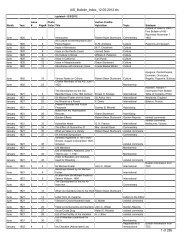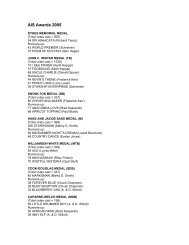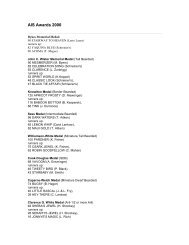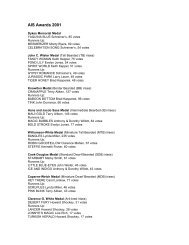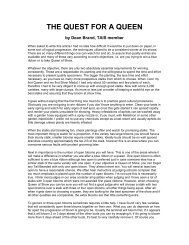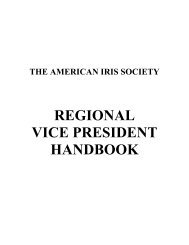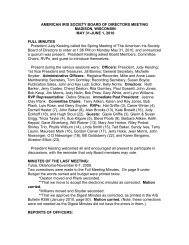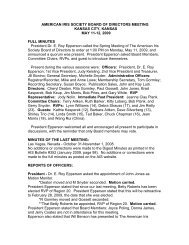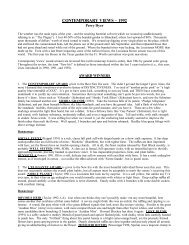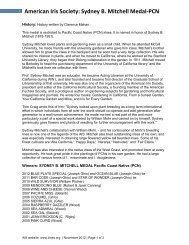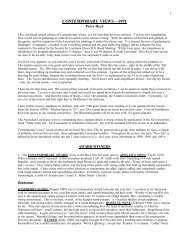contemporary views – 1988 award winners - American Iris Society
contemporary views – 1988 award winners - American Iris Society
contemporary views – 1988 award winners - American Iris Society
You also want an ePaper? Increase the reach of your titles
YUMPU automatically turns print PDFs into web optimized ePapers that Google loves.
lue plic attempts will take the iris world by storm. Congratulations to this Nebraska family of hybridizers relatively new<br />
to the scene!<br />
Runnersup:<br />
HELGA’S HAT (Nichols 1990) is a great new Space Age median, with branching, buds, form, and plant habits worthy to<br />
compete with the outstanding IB class. A succinct description would be: Take Bill Jones’ classically formed white IB,<br />
‘Avanelle’, and add consistent, tasteful white horns protruding from the heart. A clever name to reprise the world’s first<br />
Space Age median, ‘Hagar’s Helmet’ <strong>–</strong> you’ve come a long way, Mr. Nichols! SPRING SATIN (Black 1989) is a halo<br />
attempt from a different hybridizing approach, and I predict we will see all kinds of halo variations because of it. A soft,<br />
gentle palette of colors. The standards are a creamy ‘Bride’s Halo’ pattern with a distinct lemon to light yellow halo; the<br />
falls a light orchid-lavender blend, gracefully lightening in the heart, but then haloed in tan (distinctively different color<br />
than the standards’ halos). HUBBUB (Ensminger 1989) is a first in the medians, as ‘Hagar’s Helmet’ was several years<br />
ago. This IB is the first broken pattern “plicata” that ‘Purple Streaker’ and other Ensminger releases have made so<br />
popular. Yes, no 2 flowers are alike, and the patterning of purple on white is most fascinating. Surprisingly good form,<br />
and does not push the limits of the IB class, as one might fear. As usual, Alan has selected well and, as with ‘Purple<br />
Streaker’, this iris deserves more than a casual mention as a conversation piece.<br />
4. The SUN BELT AWARD is given to the Best Proven Variety, i.e., one that has been on the market long enough to<br />
thoroughly be tested (at least 4 years). The winner this year is EXTRAVAGANT (Hamblen 1983), perhaps the ultimate<br />
in “class” from one of the most tasteful hybridizers this world has known. Some hybridizers just have a sixth sense for<br />
selecting seedlings for introduction, and Melba Hamblen is the Master at it! I describe ‘Extravagant’ as “burnished<br />
amethyst”, but not as “smoky” as some other things on the market, which are themselves very attractive also. The sienna<br />
beards have just the right intensity to cap this piece of artwork. Heavily laced and moderately ruffled flowers are large but<br />
have no trouble opening. Typical Hamblen show stalk branch placement, sometimes with double sockets in the branching<br />
and sometimes not. A good judge will look at the overall length of time the iris blooms, and ‘Extravagant’ passes the<br />
test. I can already tell you, after several years of critiquing this iris, it will be the Cream of the Crop Award winner in<br />
1991. All in all, and with dozens of candidates to choose from, this has been Melba’s finest achievement.<br />
Runnersup:<br />
HELLCAT (Aitken 1983) is my perennial choice for best IB on the market, it seems. It still can’t be beat. The color<br />
saturation of this neglecta is intense and richly applied with high gloss. The branching, bud count, tight classical form <strong>–</strong><br />
it’s all there. And it is dependable, no matter how adverse the weather conditions. Double sockets extend its bloom in<br />
the garden; perfectly spaced branching and sequencing make it a hot number on the bench, and yes, it has won Best of<br />
Show honors. I have had the privilege of enjoying and evaluating CHUBBY CHEEKS (Black 1985, SDB) since its days<br />
as a seedling, and now to watch the impact it is having as a parent ….. Ah, the advantage of living only 6 blocks from one<br />
of the top 3 median hybridizers in America! Wide fat flowers, lightly, pleasingly ruffled, are adorned with changeable<br />
shadings of silver, blue, and light violet bands on a white ground plicata. Look closely and you’ll see a plicata halo in<br />
gold, producing a “double band”. This is what gives the flower its carrying power in the garden and on the show bench.<br />
It presents itself well. WARRIOR KING (Schreiner 1985) is still the finest of many good reds on the market today. A<br />
brilliant garnet red, absolutely sunfast, clean at the hafts, and superior in its shape. But what sets the standard here to<br />
judge all other reds by is its branching, bud count, and vigor (remember how we toiled over and cussed at ‘War Lord’<br />
(Schreiner), not that many years ago?). I’m a bit surprised/disappointed that this variety hasn’t been more strongly praised<br />
and rewarded in the AIS <strong>award</strong>s system. The prettiest blue-green, leaf spot resistant foliage in the whole garden.<br />
5. The DARK HORSE AWARD is given to the variety introduced within the past 10 years that I feel has been<br />
overlooked by AIS judges, and deserves/deserved higher <strong>award</strong>s: BAY RUFFLES (Warburton 1985) is the epitome of<br />
what an SDB should be. Stalks are consistently 12” tall, with 1 well-placed branch and a total bud count of 3, each<br />
opening one at a time as they should. The foliage is clean, disease resistant, and not coarse. Excellent increase, floriferous,<br />
with a superb bloom/increase ratio. Does not overbloom. The flowers are broad, yet still retain the grace and charm of a<br />
dwarf, and have light waving and ruffling that enhance the perfect form. A shimmering, sparkling light to medium blue,<br />
somewhat deeper than the color of ‘Tide’s In’ (Schreiner, TB), but with the same translucence. That this offering from one<br />
of the world’s finest, most famous hybridizers hasn’t even received an HM from AIS judges appalls me! To make matters<br />
worse, this year’s ballot listed it as “Baby Ruffles”!<br />
Runnersup:<br />
Ironically, the first slot goes to another SDB: JAZZAMATAZZ (Heidi Blyth 1986) was hybridized by Barry’s daughter<br />
while she was still in grade school (good grief!). I nearly wet my britches when this first bloomed a few years ago. It has<br />
28



